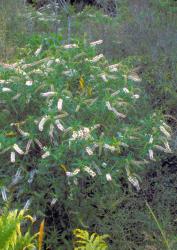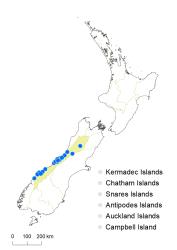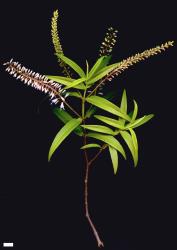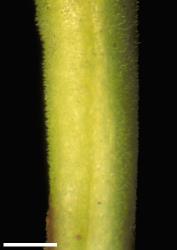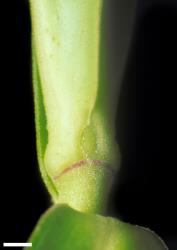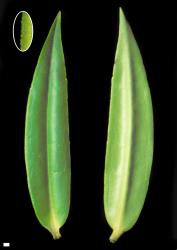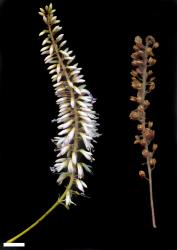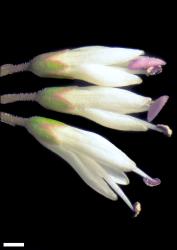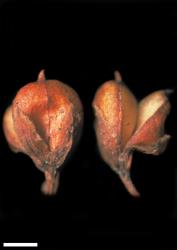- Taxon
- Gallery
- ≡ Veronica salicifolia var. paludosa Cockayne, Trans. New Zealand Inst. 48: 202 (1916)
- ≡ Hebe salicifolia var. paludosa (Cockayne) Cockayne & Allan, Trans. New Zealand Inst. 57: 18 (1926)
- ≡ Hebe paludosa (Cockayne) D.A.Norton & de Lange, New Zealand J. Bot. 36: 532 (1998)
Bushy shrub to 5 m tall. Stems erect, eglandular-puberulent; hairs usually uniform, sometimes bifarious. Leaf bud distinct, its leaves appressed at margins until fully grown; sinus rounded to elliptic-oblong. Leaves opposite-decussate, erecto-patent, spreading with age; lamina sub-coriaceous, linear-lanceolate to -elliptic, 30–86 mm long, 5.5–14.0 mm wide, glossy green above, pale green beneath; midrib evident, secondary veins evident when fresh; surfaces with eglandular hairs along midrib above and often beneath, sometimes also with minute glandular hairs; margin ciliolate, cartilaginous, entire or with distant minute teeth in 1–4 pairs; apex acuminate; base abruptly cuneate to truncate; petiole 1–4 mm long. Inflorescence a lateral raceme, 93–190 mm long; flowers crowded, 100–150, all bisexual; bracts alternate or loosely whorled, linear to narrowly deltoid, ≤ pedicels; pedicels spreading, sometimes recurved at fruiting, 1–5 mm long, puberulent all around. Calyx lobes 4, sub-acute to acuminate, 1.5–2.5 mm long, equal, mixed eglandular- and glandular-ciliolate; tube sometimes hairy. Corolla 4–6 mm diameter; tube white, 2.3–3.5 mm long, ≥ calyx, eglandular-hairy inside and sometimes outside; lobes 4, white or tinged pale purplish, erect or erecto-patent, sub-equal, narrowly linear to elliptic, 3.0–4.8 mm long, obtuse to sub-acute; nectar guides absent. Stamen filaments white, 6.5–8.5 mm long; anthers purple or blue. Style glabrous or sometimes sparsely hairy, 7.0–7.3 mm long. Capsules latiseptate, sub-acute to truncate, glabrous, 3–4 mm long, 2.0–2.5 mm at widest point. Seeds broadly ellipsoid to discoid, flattened, smooth, straw-yellow to pale brown, 0.8–1.5 mm long.
V. phormiiphila plants are similar to both V. salicifolia and V. leiophylla. Plants of V. salicifolia can be distinguished by their broader, less evenly tapered leaves, and their branchlets are sometimes glabrous (though often puberulent, like those of V. phormiiphila). Although these distinctions are minor and qualitative, plants of V. phormiiphila have 2n = 80 and occur in wetlands, often in standing water.
V. phormiiphila plants are also difficult to distinguish from V. leiophylla, but the latter have shorter and less-tapered leaves than many plants of V. phormiiphila. Again, its wetland habitat is supportive of a separate status for V. phormiiphila, although V. leiophylla also has 2n = 80, but the distinction between the two species is especially difficult where their distributions meet.
Norton and de Lange (1998) drew attention to the distinctive features of V. phormiiphila (as Hebe paludosa) as “distinctive diffusely branching habit, brittle branchlets, yellow-green faintly glaucous-tinged leaves, conspicuous decurved and twisted acumen, and the flowers, which have a longer corolla tube and acute corolla lobes which usually project forward”.
South Island: Westland (between Grey Valley and Big Bay).
Lowland wetlands, edges of lakes and lagoons, especially in the transition zone to Dacrycarpus forest, often with Phormium tenax (Norton & de Lange 1998). Recorded elevations range from 0 to 500 m.
Bayly and Kellow (2006) noted difficulties distinguishing V. phormiiphila in the northern part of its range from V. leiophylla. Norton and de Lange (1998) did not think hybridism occurs between V. phormiiphila and either V. salicifolia or V. leiophylla. Bayly and Kellow (2006) suggested hybridisation might have been involved in its origin.
Flowers: January–March; fruits: March–May.
2n = 80 (see Bayly & Kellow 2006, as Hebe paludosa).
Veronica phormiiphila is classified in V. subg. Pseudoveronica sect. Hebe and the informal group “Apertae” (large-leaved) (Albach & Meudt 2010; Bayly & Kellow 2006).
The Māori names koromiko, kōkōmuka, and variants, applied to V. stricta and V. salicifolia, might be applied also to similar large-leaved hebes, such as V. phormiiphila.



